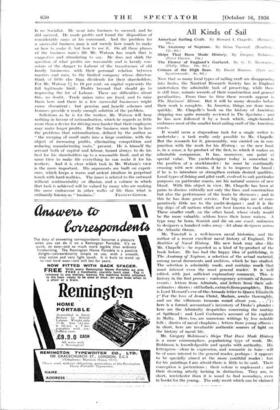All . Kinds of-Sail
The Anatomy of Neptune. By Brian Tunstall. (RoutlerIg.-.
12s. 6d.) . • •
Ships That Have Made History. BY Gregory Robinson. (Peter Davies. 156.) The Flower of England's Garland. By O. E. 31anwaring. (Philip Allan. 10s. 6d.) Crimes of the High seas. By David Masters. (Eyre athl
Spottiswoode. 8s. 6d.) . .
Now that so many local types of sailing craft are disappearing into limbo, the Nautical Research Society has in England undertaken the admirable task of preserving, While there
is still time, minute reeords-of their construction and general peculiarities. From time to time these records appear in The Mariner? Mirror. But it will be many decades before their work is complete. In America, things are done more quickly. Mr. Chapelle's book on the history of American shipping was quite recently reviewed in The Spectator : and he has now followed it -by a book which, single-handed, embraces most of the smaller local sailing craft of the American coasts.
It would Seem a stupendous task for a single writer to undertake ; a task really only possible to Mr. Chapelle. But the research -for it, presumably, was carried on in con- junction with the work for his History : so the new book is, in a sense, a by-product of the first, to which it makes an
admirable companion. It has, moreover, one point of special value. The yacht-designer today is somewhat in the position of a stockbreeder : he must be continually crossing with new strains, if he is to improve the breed : if he is to introduce or strengthen certain desired qualities. Local types of fishing and pilot craft, evolved to suit particular purposes on particular coasts, are his natural sources of new blood. With this object in view, Mr. Chapelle has been at pains to discuss critically not only the lines and construction but also the performance of the boats he discusses ; and in this he has done great service. For big ships are of com- paratively little use to the yacht-designer : and it is the big ships of all nations which are best known to each other. These smaller craft, on the other hand, whose study would be the more valuable, seldom leave their home waters. A iype may be born, flourish and die on one coast, unknown to designers a hundred miles away—let alone designers across the Atlantic Ocean.
Mr. Tunstall is a well-known naval historian, and the author of a recent excellent naval history of England, The
Realities of Naval History. His new book may also—like Mr. Chapelle's—be regarded as a kind of by-product of the book before. He has had the happy idea of publishing, in The Anatomy of Neptune, a selection of the actual material, among naval documents and archives, which he ha s studied. The selection is admirably made, and contains muelOthat must interest even the most general reader: It edited, with just suffiCient explanatory comment, This- history in the first person : contemporary aCentults'af ranusus events : letters from Admirals, aial.ilettei frinit-their.'sub- ordinates: diaries : old ballads, extrae*frompamptdets. Here is Lord Howard's eve-of-the-Armada letter to Queen Elizabeth (" For the love of Jesus Christ, Madam, awake thoroughly, and .see the villainous treasons round about you. . . .") :
here is a formal, accountant's inventory of Drake's plunder : here are the Admiralty despatches concerning the mutiny at Spithead : and Lord Cochrane's account of his exploits in Malta. Here, too, are numerous writings by, less notable folk : diaries of naval chaplains ; letters from young officers : in short, here are invaluable authentie soureeS of light on the history of naval life.
Mr. Gregory Robinson's Ships That Have Made History is a more commonplace, popularising type of work. Mr. Robinsori, is knoWledgeable and speaks with authority. His letterpress—clear in expression, and- romantic in tone will be of some interest to the general reader, perhaps : it appears to 'be specially aimed- at tbe more-, youthful reader : but for his paintings :I am afraid there is little to be said Their conception is pretentious : their colour is unpleasant : and their drawing utterly lacking in distinction. They are, in
short, wretcheder than it is usual to find nowadays, even in books for the young. The Pnly merit which can-be claimed for them is a lack of technical inaccuracies ; but in that case surely plain diagrams would have been more satisfactory.
Mr. Manwaring, of the -London Library, has collected in a single volume a series of essays on different aspects of the history of the Navy. They are full of the copious informa-
tion which one would expect from a man of omnivorous knoWledge : voluminous and interesting.
Strictly speaking, Crimes of The High Seas is a book -for sleuth-hounds rather than for sea-dogs. It is a collection of the most excellent swindles attempted on the under- writers of Lloyds. Its interest rather lies in the ingenuity with which the crieries„were planned and engineered than in the fact that they took place on the high seas. 1 would recommend particularly that crime which is described as "A -Deal in Onions " : a swindle which (although a fact),. foe the douhle-banked ingenuity of its conception and the logical intelligence of its detection, almost deserves to rank
amongst the famous crimes of fiction. •
RICHARD HUGHES,





















































 Previous page
Previous page